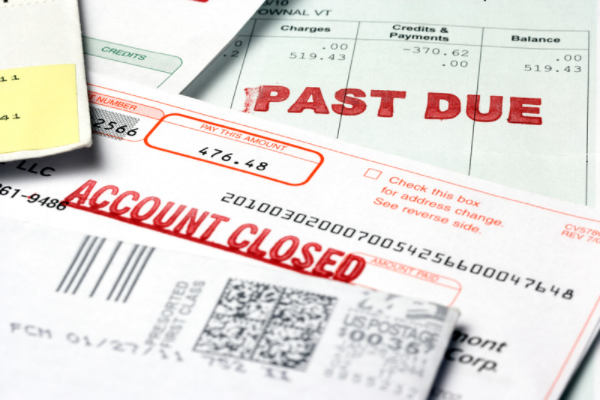"I had good intentions and the highest hopes. But I know right now it probably doesn't even show." – Easy on Me
The lyrics of Adele's latest song may be specific to her, but its intriguing message may also stir emotions in those going over the demand letters (or emails) from lenders.
Receiving a demand letter for outstanding loans is not good news, but ignoring it (hoping that it will go away) is not a wise move, either. Don't wait until it piles up because the interest rates may add up, and you might end up owing more than your loan amount. If it is a secured loan with collateral such as a car loan or a housing loan, you may run the risk of foreclosure or repossession.
The next essential step is to read the letter, no matter how long or short it is, and see if there are any deadlines for you to respond or to make your debt payment.
When the country's main carrier, Philippine Airlines, announced that it filed for creditor protection under Chapter 11 of the U.S. Bankruptcy Code, many were interested to know if there are also bankruptcy proceedings in the Philippines.
Before you reply to the demand letter and mention the words "bankrupt" or "bankruptcy" to describe your financial state to your lender or creditor, understand first what these terms are and how they work in the Philippine context.
Struggling with Debt Payment? Know the Legal Remedies for Debtors in the Philippines

1. What does being bankrupt mean?
The word "bankrupt" refers to one who is unable to pay debts. Meanwhile, the word “bankruptcy” comes from the Italian phrase banca rotta, which means broken bench.
In the past, Italian merchants would set up shop using benches, and if they didn't have funds to keep their business, it would be broken in two to prevent them from conducting any more business. The term "being broke," when referring to someone who does not have money, was derived from a broken bench.
2. What is the difference between insolvency and bankruptcy?
It depends on the law or legislation that governs a state or jurisdiction. Although insolvency and bankruptcy are court proceedings and have been used interchangeably, legally speaking, they are not the same.
Bankruptcy proceedings vary from one country to another with different legal procedures and consequences. Many countries have bankruptcy laws: Singapore, Indonesia, Brunei, Ireland, Japan, the United Kingdom, and the United States, to name a few.
In other countries, bankruptcy is a preferable option if it is no longer possible to repay the debts. It becomes the last resort because it affects one's creditworthiness, resulting in difficulty obtaining loans, getting a job, or appointment to public office.
Philippine laws do not make any distinction between bankruptcy and insolvency.
Read more: Ask Moneymax: What to Do When Harassed and Threatened by Lenders? SLAP!
3. Are there bankruptcy proceedings in the Philippines? Can I file for bankruptcy?
No. There is no terminology as bankruptcy in Philippine laws. The Philippines does not have a legal proceeding on bankruptcy, but the closest is insolvency under Republic Act (RA) 10142 or the Financial Rehabilitation and Insolvency Act (FRIA) of 2010,[1] which took effect on July 18, 2010.
Interestingly, the Insolvency Law (Act No. 1956) has existed in the Philippines for more than 100 years since 1909. It provided for procedural rules of Suspension of Payments over individuals and companies, as well as liquidation of companies. FRIA repealed it in 2010.
FRIA adopted the United Nations Commission on International Trade Law (UNCITRAL) Model Law on Cross-Border Insolvency,[2] which allows for the recognition of foreign insolvency proceedings. This is why Philippine Airlines also filed a petition in Pasay City Regional Trial Court (RTC) for the recognition of its Chapter 11 filing in the U.S.[3]
4. What does being insolvent mean?

In the Philippines, under the FRIA law, being insolvent refers to the financial condition of a debtor that is unable to pay its liabilities as they fall due in the ordinary course of business or has liabilities that are more than its assets.
For example, let's say you have properties worth PHP 1 million, and your total loan amount due is PHP 1.1 million (credit card, car loan, housing loan). You can be considered insolvent if you cannot pay for your loan because you don't have any money, or even if you have cash, it is insufficient to pay for your liabilities. In this example, the liability of PHP 1.1 million is more than the PHP 1 million worth of properties.
FRIA also enumerates those considered acts of insolvency, which includes departing the Philippines with intent to defraud creditors.
5. Can I file for financial rehabilitation and insolvency proceedings?
Under the FRIA law, the following individuals and entities are allowed to file for financial rehabilitation and insolvency proceedings in the Philippines:
- Partnerships and corporations registered with the Securities and Exchange Commission (SEC)
- Sole proprietorships registered with the Department of Trade and Industry (DTI)
- Individual debtors who are residents and citizens of the Philippines.
If you fall into one of these categories, then you can file for such proceedings. In insolvency proceedings, the debtor's assets are going to be converted into cash for distribution among its creditors.

6. Under FRIA, what remedies are available to debtors seeking protection from creditors?
Individual debtors may avail of the following:
- Suspension of Payment
- Voluntary Liquidation
For debtors that are sole proprietors, partnerships, and corporations, the following types of proceedings may be availed of:
- Voluntary Rehabilitation
- Pre-negotiated Rehabilitation
- Voluntary Liquidation
The cases of Suspension of Payments, Rehabilitation, and Liquidation are summary and non-adversarial, which means that the court issues the judgment without a full-blown trial. As a minimum requirement, a schedule of debts and liabilities, inventory of assets, and proposed agreement with the creditors must be attached to the petition. Pleadings such as a motion to dismiss, motion for extension, or motion for postponement are not allowed.
The goal is to expedite the proceedings while ensuring a timely, fair, transparent, effective, and efficient rehabilitation or liquidation of debtors. Like in any other court case, you must be represented by a lawyer.
7. What is Suspension of Payments?

When you possess enough property to cover all your debts, but it is impossible to pay them on due dates, you may file a verified petition to declare you in a state of Suspension of Payments in the RTC acting as a special commercial court in the province or city where you reside. This can be filed only by individual debtors and not by sole proprietorship, corporation, or partnership.
In Suspension of Payments, the individual debtor is not insolvent because of sufficient assets to cover its liabilities.
An example is if you have assets worth PHP 1 million, and your total loan amount is PHP 80,000. You are not insolvent because your assets are more than your liabilities. Still, assuming that you will not be able to pay on the deadline because the company where you worked closed down due to the pandemic, you can file for a Petition for Suspension of Payments. Here, you are just asking for more time to be able to meet your obligations.
Suppose the court finds that your petition is sufficient in form and substance. In that case, it may issue an Order that requires the following, among others, during the pendency of the Suspension of Payments:
- To call for a meeting of all the creditors named in the schedule of debts and liabilities
- To publish the Order once a week for two consecutive weeks in a newspaper of general circulation in the province or city where you filed the petition
- Not to sell, transfer, encumber or dispose of properties except those used in the ordinary operations of commerce
- Not to make any payment outside the necessary expense of your business
8. What is Rehabilitation?
Under FRIA law, Rehabilitation refers to restoring the debtor to a condition of successful operation and solvency. It must be shown that the continuation of the business is economically feasible, and the creditors will be able to recover by way of the present value of payments projected in the Rehabilitation Plan. The aim is to restore the financial well-being and viability of the insolvent debtor through various means such as, but not limited to, debt forgiveness, debt rescheduling, and reorganization.
Rehabilitation is not available to individual debtors. It is available only to sole proprietorships, partnerships, and corporations.
9. Can a debtor file for Rehabilitation?

Yes. An insolvent debtor (a sole proprietorship, partnership, or corporation) may initiate voluntary proceedings under FRIA by filing a Petition for Rehabilitation with the RTC acting as a special commercial court. It must be approved or filed by the sole proprietor, or by a majority of the partners in case of a partnership, or, in the case of a corporation, by a majority vote of the board of directors or trustees and authorized by the vote of the stockholders representing at least two-thirds (2/3) of the outstanding capital stock, or in case of a nonstock corporation, by the vote of at least two-thirds (2/3) of the members.
The Petition for Rehabilitation must establish the insolvency of the debtor and that Rehabilitation is viable. FRIA also enumerates what must be attached to the petition.
An example is when a corporation has a loan of PHP 12 million, and the claim has not yet matured, but the corporation foresees that it is unable to pay its dues when they fall due, it can file for rehabilitation proceedings and continue with its business operations.
The rehabilitation proceedings may be court-supervised, pre-negotiated, or through out-of-court or informal restructuring/workout agreement or Rehabilitation Plan.
10. What is Liquidation under FRIA?
Liquidation is a proceeding where a debtor is insolvent, and the debtor's assets are sold and converted into money under the FRIA law.
There are two kinds of liquidation proceedings: voluntary liquidation or involuntary liquidation. In a voluntary liquidation, the insolvent debtor files a Petition for Liquidation in RTC acting as a special commercial court. It can also be done through a verified motion in court-supervised or pre-negotiated rehabilitation proceedings. For individual debtors, the owed amount must be more than PHP 500,000.00.
A proceeding is an involuntary liquidation if three or more creditors initiate it with a total claim of at least PHP 1 million or at least 25% of the subscribed capital stock or partners' contributions. Similar to voluntary liquidation, the Petition for Liquidation must show no genuine issue of fact or law on the petitioner's claims. The demandable payments were not made for at least 180 days or that the debtor failed to meet its liabilities as they fall due. Liquidation is resorted to when it is not very likely that the debtor can still be rehabilitated. The Liquidation Order in voluntary liquidation is issued even without a trial.
For example, a financially distressed corporation has debts of PHP 10 million without cash flow. It is no longer able to pay its obligations such that Rehabilitation is no longer realistic. It can file for a verified petition for liquidation. This will allow the corporation to wind up its affairs and distribute its assets among its creditors.
Final Thoughts
In negotiating your debt payment with creditors, remember that they are always interested to know when and how you will be able to pay them back.
This global pandemic has caused economic pain to many consumers. If you are experiencing financial problems, the good news is that many lenders, such as banks, credit card providers, lending companies, and financing companies, are still offering modified payment plans, including loan restructuring, lower interest rates, grace periods, and waivers of fees. It would be better to ask your lender about these to provide more details about your particular situation and to know what plan works for you.
Be transparent to your creditors. If the negotiation with your lender fails, there are available remedies in court for insolvent debtors, as discussed above. And as Adele's song says, "there is hope in these waters."
- Ask Moneymax: I Can’t Pay Off My Debt This Pandemic. What Should I Do?
- 6 Ways to Get Out of Debt Faster Despite Having Low Income
Email Us Your Questions!
Got questions about managing debt and loan payments? Email them to askmoneymax@moneymax.ph (with this subject line: Ask Moneymax), and we will try to address them in one of our next articles.
Editor's note: This is the second in a series of articles helping Filipinos manage debt in the new normal. Stay tuned for more information and advice from the Ask Moneymax column!

Sources:
- [1] Financial Rehabilitation and Insolvency Act (FRIA) of 2010 (Official Gazette)
- [2] Insolvency (United Nations Commission On International Trade Law)
- [3] PAL asks Pasay Court to recognize US Chapter 11 bankruptcy protection filing (ABS-CBN News, 2021)
DISCLAIMER: The information provided on this website does not, and is not intended to, constitute legal or financial advice. All information, content, and materials available on this site are for general informational purposes only. Information on this website may not constitute the most up-to-date legal or other information and is subject to change without notice.
No user of this site should act or refrain from acting on the basis of information on this site without first seeking legal advice from their own attorney in the relevant jurisdiction. Only your individual attorney can provide assurances that the information contained herein – and your interpretation of it – is applicable or appropriate to your particular situation. Use of, and access to, this website or any of the links or resources contained within the site do not create an attorney-client relationship between the reader, user, or browser and website authors, contributors, contributing third parties, and their respective employers.
All liability with respect to actions taken or not taken based on the contents of this site are hereby expressly disclaimed. The content on this posting is provided "as is;" no representations are made that the content is error-free.







.png)

